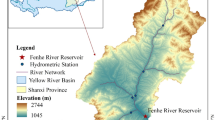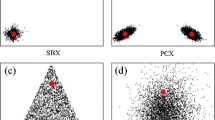Abstract
An improved non-dominated sorting genetic algorithm-III (ENSGA-III) is proposed to solve reservoir flood control operation (RFCO) problem. The highest upstream water level and the largest discharge of the dam are considered as two objective functions for the RFCO problem. In the proposed ENSGA-II, there are three aspects of improvements in the original NSGA-III. First, orthogonal design is adopted to generate initial population for making the population more spread and uniform in the search space. Secondly, ε-dominance and constraint violation strategy is designed to find the non-dominated solution set. Thirdly, double populations are updated with three-archive strategy for producing better individuals in evolutionary process. The performance of the proposed ENSGA-III has been tested on the RFCO problem of Three Gorges Reservoir. The simulation results show that the proposed method is able to produce well distributed Pareto optimal solutions for the multi-objective reservoir flood control operation problem in term of solution quality. Compared with the results obtained by other methods, the superiority of the ENSGA-III for solving the RFCO problem is verified.


Similar content being viewed by others
Explore related subjects
Discover the latest articles and news from researchers in related subjects, suggested using machine learning.References
Ahmad S, Simonovic SP (2000) System dynamics modeling of reservoir operations for flood management. J Comput Civ Eng 14(3):190–198
Chang JX, Meng XJ, Wang ZZ, Wang XB, Huang Q (2014) Optimized cascade reservoir operation considering ice flood control and power generation. J Hydrol 519:1042–1051
Che D, Mays LW (2015) Development of an optimization/simulation model for real-time flood-control operation of river-reservoirs systems. Water Resour Manag 29:3987–4005
Chen ZH, Yuan XH, Ji B, Wang PT, Tian H (2014) Design of a fractional order PID controller for hydraulic turbine regulating system using chaotic non-dominated sorting genetic algorithm II. Energy Convers Manag 84:390–404
Chen J, Zhong PA, Xu B, Zhao YF (2015) Risk analysis for real-time flood control operation of a reservoir. J Water Resour Plan Manag 141(8):04014092-1-10
Cheng CT, Chau KW (2001) Fuzzy iteration methodology for reservoir flood control operation. J Am Water Resour Assoc 37(5):1381–1388
Chiang PK, Willems P (2015) Combine evolutionary optimization with model predictive control in real-time flood control of a river system. Water Resour Manag 29:2527–2542
Choudhury P (2010) Reservoir flood control operation model incorporating multiple uncontrolled water flows. Lakes Reserv Res Manag 15(2):153–163
Deb K, Jain H (2014) An evolutionary many-objective optimization algorithm using reference-point-based nondominated sorting approach, Part I: solving problems with box constraints. IEEE Trans Evol Comput 18(4):577–601
Fu GT (2008) A fuzzy optimization method for multicriteria decision making: an application to reservoir flood control operation. Expert Syst Appl 34(1):145–149
Hashemi H, Bazargan J, Mousavi SM, Vahdani B (2014) An extended compromise ratio model with an application to reservoir flood control operation under an interval-valued intuitionistic fuzzy environment. Appl Math Model 38:3495–3511
He YY, Xu QF, Yang SL, Liao L (2014) Reservoir flood control operation based on chaotic particle swarm optimization algorithm. Appl Math Model 38:4480–4492
Hsu NS, Wei CC (2007) A multipurpose reservoir real-time operation model for flood control during typhoon invasion. J Hydrol 336(3):282–293
Ji B, Yuan XH, Li XS, Huang YH, Li WW (2014) Application of quantum-inspired binary gravitational search algorithm for thermal unit commitment with wind power integration. Energy Convers Manag 87:589–598
Kim T, Heo JH, Jeong CS (2006) Multireservoir system optimization in the Han River basin using multi-objective genetic algorithms. Hydrol Process 20(9):2057–2075
Leung Y, Wang Y (2001) An orthogonal genetic algorithm with quantization for global numerical optimization. IEEE Trans Evol Comput 5(1):41–53
Li C, McPhee J, Yeh WWG (2007) A diversified multiobjective GA for optimizing reservoir rule curves. Adv Water Resour 30(5):1082–1093
Li YH, Zhou JZ, Zhang YC, Qin H, Liu L (2010) Novel multiobjective shuffled frog leaping algorithm with application to reservoir flood control operation. J Water Resour Plan Manag 136(2):217–226
Luo JG, Chen C, Xie JC (2015b) Multi-objective immune algorithm with preference-based selection for reservoir flood control operation. Water Resour Manag 29:1447–1466
Luo JG, Qi YT, Xie JC, Zhang X (2015a) A hybrid multi-objective PSO–EDA algorithm for reservoir flood-control operation. Appl Soft Comput 34:526–538
Maryam SA, Alireza GH, Fatemeh S (2016) Controlling floods by optimization methods. Water Resour Manag 30:4053–4062
Nagesh Kumar D, Baliarsingh F, Srinivasa Raju K (2010) Optimal reservoir operation for flood control using folded dynamic programming. Water Resour Manag 24:1045–1064
Needham J, Watkins D, Lund J, Nanda S (2000) Linear programming for flood control in the Iowa and Des Moines rivers. J Water Resour Plan Manage 126:118–127
Qi Y, Bao L, Ma XL, Miao QG, Li XD (2016) Self-adaptive multi-objective evolutionary algorithm based on decomposition for large-scale problems: a case study on reservoir flood control operation. Inf Sci 367:529–549
Reddy MJ, Kumar DN (2007) Multiobjective differential evolution with application to reservoir system optimization. J Comput Civ Eng 21(2):136–146
Yuan XH, Ji B, Zhang SQ, Tian H, Hou YH (2014) A new approach for unit commitment problem via binary gravitational search algorithm. Appli Soft Comput 22:249–260
Acknowledgements
This work was supported by National Natural Science Foundation of China (No. 51379080, No. 41571514) and the Fundamental Research Funds for the Central Universities (No. 2017KFYXJJ204).
Author information
Authors and Affiliations
Corresponding author
Rights and permissions
About this article
Cite this article
Chen, C., Yuan, Y. & Yuan, X. An Improved NSGA-III Algorithm for Reservoir Flood Control Operation. Water Resour Manage 31, 4469–4483 (2017). https://doi.org/10.1007/s11269-017-1759-6
Received:
Accepted:
Published:
Issue Date:
DOI: https://doi.org/10.1007/s11269-017-1759-6




